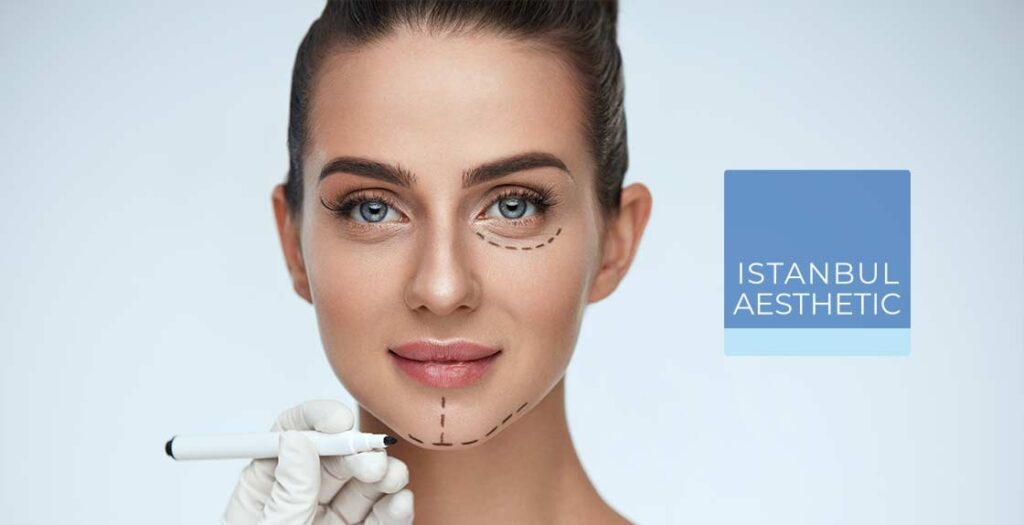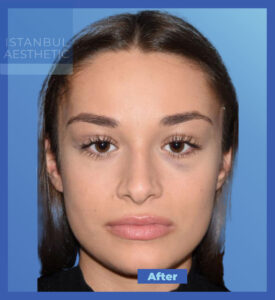At the early period of post-surgery, you may have mild pain but this period is gone through easily with prescribed pain killers in general. A mild tenseness, oedema and a tingling sensation that is soothable with painkillers may be seen at the chin. Lying with the head at an upright position and applying cold compression are recommended for swellings and bruises.

What is Chin Aesthetics Surgery?
Chin aesthetics surgery, also known as genioplasty or mentoplasty, is a cosmetic surgical procedure aimed at enhancing the appearance of the chin by altering its size, shape, or position. It is commonly performed to correct a receding or weak chin, improve facial harmony and balance, or address asymmetry and irregularities in the chin contour.
Here’s an overview of how chin aesthetics surgery is typically performed:
Consultation: Before the procedure, the patient will have a consultation with a qualified plastic surgeon to discuss their goals, concerns, and expectations regarding their chin aesthetics. The surgeon will evaluate the patient’s facial anatomy, proportions, and chin structure to determine the most appropriate surgical approach and create a personalized treatment plan.
Anesthesia: Chin aesthetics surgery is usually performed under general anesthesia or local anesthesia with sedation, depending on the extent of the surgery and the patient’s preferences.
Incisions: The surgeon makes discreet incisions in strategic locations, typically inside the mouth along the lower lip or under the chin, to access the underlying structures of the chin. The choice of incision location depends on the specific goals of the surgery and the extent of correction needed.
Augmentation or Reduction: Depending on the patient’s desired outcome, the surgeon may perform either chin augmentation or chin reduction surgery:
Chin Augmentation: In chin augmentation surgery, the surgeon adds volume and projection to the chin using implants or bone grafts to achieve a more prominent and balanced chin profile.
Chin Reduction: In chin reduction surgery, the surgeon removes excess bone or soft tissue from the chin to reduce its size and projection, creating a more proportionate and harmonious facial appearance.
Tissue Adjustment and Reshaping: After the augmentation or reduction is performed, the surgeon may adjust and reshape the underlying bone and soft tissues of the chin to achieve the desired contour and symmetry. This may involve repositioning the chin bone, sculpting the soft tissue, or reattaching muscles and ligaments as needed.
Closure and Recovery: Once the surgery is complete, the incisions are closed with sutures or surgical staples, and a bandage or compression garment may be applied to the chin to minimize swelling and support the healing process. Patients typically experience some bruising, swelling, and discomfort following the procedure, which can be managed with pain medication and proper post-operative care.
Results: The final results of chin aesthetics surgery become gradually apparent as swelling subsides and the tissues settle into their new position. Patients can expect a more balanced and harmonious chin profile, with improved facial proportions and overall facial aesthetics.
Chin aesthetics surgery is a highly effective way to enhance the appearance of the chin and improve facial harmony and balance. It’s essential to undergo chin aesthetics surgery from a qualified and experienced plastic surgeon to ensure the best possible outcome and minimize the risk of complications. Reputable medical facilities like the Istanbul Aesthetic Center (IAC) offer comprehensive facial aesthetic services, including chin aesthetics surgery, providing patients with expert care and personalized treatment to achieve their desired aesthetic goals.
If your chin structure is unproportional to your face and if this bothers you, YES, you may go under “Chin Aesthetics Surgery”.
You had better share all your expectations and concerns with your doctor. During examination, you should reply to any questions to be asked about your general health condition in details and inform your doctor about your past diseases and medications you use.
Your surgery to be performed in our hospital will be carried out with sedation + under local anaesthesia or general anaesthesia as to the practice. Its approximate duration is 1-1.5 hours, you may need to stay at the hospital for an overnight.
You will be examined and informed by an anaesthesia doctor before the prominent ear surgery. Blood diluent medications, vitamins and factors affecting anaesthesia such as alcohol and smoking should be discontinued starting from the date foreseen by your doctor.

Welcome to our new hospital building! Experience excellence in care and comfort with us.
Quick Contacts
- Phone : +90 212 266 07 42
- Email : bilgi@ia-center.com
- Address : Balmumcu, Bestekar Şevki Bey Sk. No:16-18, 34353
- Provience : Beşiktaş/İstanbul








